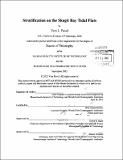| dc.contributor.advisor | Britt Raubenheimer. | en_US |
| dc.contributor.author | Pavel, Vera L. (Vera Lynn) | en_US |
| dc.contributor.other | Woods Hole Oceanographic Institution. | en_US |
| dc.coverage.spatial | n-us-wa | en_US |
| dc.date.accessioned | 2013-03-28T18:11:06Z | |
| dc.date.available | 2013-03-28T18:11:06Z | |
| dc.date.copyright | 2012 | en_US |
| dc.date.issued | 2012 | en_US |
| dc.identifier.uri | http://hdl.handle.net/1721.1/78175 | |
| dc.description | Thesis (Ph. D.)--Joint Program in Applied Ocean Science and Engineering (Massachusetts Institute of Technology, Dept. of Mechanical Engineering; and the Woods Hole Oceanographic Institution), 2012. | en_US |
| dc.description | Cataloged from PDF version of thesis. | en_US |
| dc.description | Includes bibliographical references (p. 79-84). | en_US |
| dc.description.abstract | Estuarine density stratification may be controlled primarily by cross-shore processes (analogous to longitudinal control in narrow estuaries), or by both cross- and alongshore processes (typical of coastal plumes). Here field observations and numerical modeling are used to investigate stratification on the low-sloped, periodically inundated Skagit Bay tidal flats. Advection of stratification by the depth-averaged velocity, straining of the horizontal density gradient by velocity shear, and turbulent mixing are shown to be the dominant processes. On the south-central flats (near the south fork river mouth) velocities are roughly rectilinear, and the largest terms are in the major velocity direction (roughly cross-shore). However, on the north flats (near the north fork river mouth), velocity ellipses are nearly circular owing to strong alongshore tidal flows and alongshore stratification processes are important. Stratification was largest in areas where velocities and density gradients were aligned. The maximum stratification occurred during the prolonged high water of nearly diurnal tides when advection and straining with relatively weak flows increased stratification with little mixing. Simulations suggest that the dominance of straining (increasing stratification) or mixing (decreasing stratification) on ebb tides depends on the instantaneous Simpson number being above or below unity. | en_US |
| dc.description.statementofresponsibility | by Vera L. Pavel. | en_US |
| dc.format.extent | 84 p. | en_US |
| dc.language.iso | eng | en_US |
| dc.publisher | Massachusetts Institute of Technology | en_US |
| dc.rights | M.I.T. theses are protected by
copyright. They may be viewed from this source for any purpose, but
reproduction or distribution in any format is prohibited without written
permission. See provided URL for inquiries about permission. | en_US |
| dc.rights.uri | http://dspace.mit.edu/handle/1721.1/7582 | en_US |
| dc.subject | Joint Program in Applied Ocean Science and Engineering. | en_US |
| dc.subject | Mechanical Engineering. | en_US |
| dc.subject | Woods Hole Oceanographic Institution. | en_US |
| dc.subject.lcsh | Tidal flats Washington (State) Skagit Bay | en_US |
| dc.subject.lcsh | Tidal currents Washington (State) Skagit Bay | en_US |
| dc.subject.lcsh | Estuarine hydrology Washington (State) Skagit Bay | en_US |
| dc.title | Stratification on the Skagit Bay tidal flats | en_US |
| dc.type | Thesis | en_US |
| dc.description.degree | Ph.D. | en_US |
| dc.contributor.department | Joint Program in Applied Ocean Physics and Engineering | en_US |
| dc.contributor.department | Woods Hole Oceanographic Institution | en_US |
| dc.contributor.department | Massachusetts Institute of Technology. Department of Mechanical Engineering | |
| dc.identifier.oclc | 829760763 | en_US |

